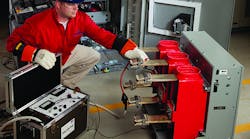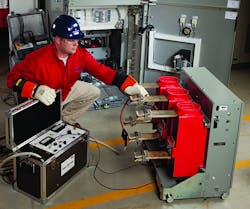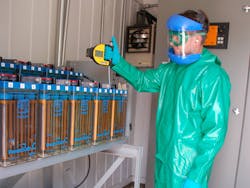Your industrial uninterruptible power supply (UPS) is the foundation of the emergency power system, and it ensures the continual operation of your facility under fault or other abnormal conditions. Should power be interrupted for any reason, your UPS and backup system must support the critical load, or you risk shutdown of critical processes, controls systems, and fire/life safety systems — putting your business and your employees at risk.
UPS failures have been known to cost businesses millions in lost product, damaged equipment, and lost production time, not to mention costly regulatory fines. The Electric Power Research Institute (EPRI) estimates the national cost of power interruptions is approximately $80 billion per year to electrical customers in the United States, with momentary interruptions accounting for two-thirds of the total cost.
Despite understanding this reality, many industrial facilities and power plants still struggle to find the budget, the time, or the expertise to implement maintenance practices needed to properly care for their aging infrastructure and keep up with ever-changing regulatory requirements. These complexities, coupled with rising costs, mean that power system protection often falls by the wayside, thereby compromising the reliability and performance of critical electrical assets.
In spite of the challenges, investing in emergency power system protection remains one of the smartest and most cost-effective steps you can take to ensure continuous power to both your critical processes and your entire plant. Studies have shown that nearly 67% of all load losses are preventable, including failures attributed to product design, poor quality, operator error, battery failure, defective parts, and insufficient maintenance.
This article looks at some of the most effective protection measures you can take to help prevent such failures. Implementing the following protection strategies can help make sure your emergency power system is ready to operate flawlessly when you need it most.
Startup and commissioning
Emergency power systems are becoming increasingly complex, and the deployment of such systems is a big job. A lot could go wrong before your UPS and other system components are ever put into service, considering that the majority of early equipment failures are traced to installation, startup, or design deficiencies. Improper coordination and calibration of protective devices, wiring errors, design errors, and human error are other major culprits behind unnecessary outages. The commissioning process is a documented quality assurance program that finds and resolves such problems before the system is started.
Commissioning ensures that the emergency power system has been correctly installed and configured. It also ensures the system will operate reliably, and perform as designed and in accordance with the facility owner’s needs. The tests and checks conducted during the commissioning process verify that the system operates as an integrated system and will support the critical load during power interruptions.
A comprehensive approach to commissioning typically includes visual and mechanical inspections of the equipment and subassemblies, electrical and mechanical functional tests, operational checks of individual components, and end-to-end system testing. Commissioning can also include validation of the appropriate maintenance and safety programs, training for your operations and maintenance staff, identification of safety problems throughout the project, and verification that any efficiency features built into the system function as intended.
The more robust the commissioning process, the greater the benefits will be. While improving availability is one of the greatest values of commissioning, the process can also improve efficiency, and enhance safety and compliance. Additionally, commissioning reduces costs by improving emergency power system performance throughout your facility’s life cycle, which helps reduce operation, maintenance, and energy consumption costs. Add these day-to-day cost savings to what your business can save by avoiding problems before startup and/or preventing the staggering costs of an unplanned outage, and commissioning delivers a clear return on investment.
Predictive diagnostics
Imagine knowing well in advance that a system failure is going to occur. With this knowledge, you can take action to correct issues with your emergency power system, effectively preventing unplanned outages and the high costs that come with them. This is exactly what predictive maintenance is designed to do. Services such as infrared testing and partial discharge testing help identify defective power system components and other conditions that could result in fire or electrical breakdown.
For example, partial discharge testing of medium-voltage cables and/or switchgear can help identify insulation deterioration, which is the leading cause of electrical failures, according to National Fire Protection Association’s “Recommended Practice for Electrical Equipment Maintenance” (NFPA 70B). Partial discharges are small electrical sparks that occur within the insulation of medium- and high-voltage electrical assets. These discharges are often present well in advance of insulation failure, providing an important indication of such impending failure. Through online and offline testing, along with monitoring of electrical assets, plant operators and maintenance personnel can gain important insight into the quality of insulation and its impact on overall equipment health.
Infrared testing (also known as thermographic imaging) is another important predictive diagnostic. The NFPA 70B standard and most insurance companies recommend annual infrared inspections. These tests look for excessive heat that can be a sign of corrosion, loose connections, misalignment, or overload conditions — all problems that can result in potentially serious issues for your business if left unchecked.
By finding trouble spots — and taking action to correct them before failures occur — you can make the best use of maintenance dollars and avoid full-blown disasters.
Regular preventive maintenance
In addition to predictive diagnostics, a regular preventive maintenance program is another effective way to detect and correct incipient failures before they develop into major defects that could translate into costly downtime. Every emergency power system contains life-limited components, and these components must be maintained according to the manufacturer’s specifications in order to maximize their life and ensure reliable, safe, and efficient operation. These maintenance steps are analogous to balancing the tires or replacing the battery in your car.
Maintenance is also essential for complying with standards from the Institute of Electrical and Electronics Engineers (IEEE) and meeting regulatory requirements, including those mandated by the Occupational Safety and Health Administration (OSHA), the North American Electric Reliability Corporation (NERC), and NFPA.
A proper preventive maintenance program for the emergency power system should include maintenance of the UPS, batteries, inverters, and associated components and follow recommendations from the InterNational Electrical Testing Association (NETA) and NFPA.
UPS maintenance
Preventive maintenance for the UPS system should include visual and mechanical inspections and tests of safety functions, control function, batteries, and connections. Maintenance activities should also include replacement of any life-limited components as required.
Battery maintenance
The UPS and emergency power system are only as reliable as the batteries that support it. In the event of a power outage, a single bad cell in a string of batteries could compromise the entire backup system and leave a plant or facility without protection. Battery inspections help identify weak or failing batteries so they can be replaced as needed. Battery maintenance should also include regular maintenance for battery chargers and periodic inspections of battery racks.
Inverter maintenance
Inverter features and functionality should be periodically inspected and tested to ensure proper operation. This should include inspecting input/output voltage and currents, and verifying system alignment, along with the verification of DC bus voltage and ripple on the battery plant.
Static switch maintenance
Maintenance should include periodically verifying the proper operation of the static switch or automatic bypass. Inspections should check the input and output voltages and currents, and verify system alignment.
Life-extension services
One of the biggest hurdles to proper emergency power system protection is aging and obsolete equipment. Worn equipment comes with a higher risk for failure and increased maintenance requirements, and it can pose additional safety risks for employees. In other words, it’s more expensive to operate and maintain. But the cost of complete system replacement is usually not an option given today’s tight budgets.
Life-extension services, such as retrofits and renewals, can provide the answer many plants and facilities need. Upgrading and retrofitting equipment can often be performed at a cost savings of up to two-thirds the cost of new replacements. Such services can restore emergency power systems to original equipment manufacturer (OEM) specifications, improving the efficiency and reliability of equipment. Many renewal services even include warranties on parts or labor.
A UPS renewal may include the replacement of major system components and the modernization of control systems for the UPS, inverter, and/or battery charger. Such a service should also include testing and calibration to ensure optimized system performance.
Regulatory compliance
Taking steps to safeguard your emergency electrical power system isn’t just smart business; today it’s also a requirement of organizations such as OSHA and NFPA. Given the increasing frequency and severity of electrical accidents in the workplace, these organizations are mandating safer electrical work practices to afford employees better protection on the job, and proper maintenance is an important part of this equation.
Specifically, the latest version of NFPA 70E: Standard for Electrical Safety in the Workplace mandates maintenance on all electrical equipment — not just overcurrent protective devices — in accordance with manufacturers’ instructions or industry consensus standards. Facility owners and managers must also maintain their single-line diagram in an up-to-date and legible condition as it enables proper maintenance. Furthermore, they must keep records of maintenance activities, including documentation to show that overcurrent protective devices have been properly maintained, tested, and inspected.
OSHA requirements are based on and make reference to NFPA 70E guidelines. This means that if you fail to properly maintain your emergency power system’s electrical equipment, you not only increase your risk of costly downtime, but you could also be facing a greater risk of hefty regulatory fines and fees if the failure incident draws OSHA in to investigate.
Protect the system that protects your business
With tight budgets, ever-changing regulatory requirements, and aging infrastructure, the complexities of emergency power system protection are significant challenges for industrial facilities and power plants alike. But they are challenges that demand to be addressed, given the low tolerance for unplanned outages and the staggering costs/implications of electrical accidents.
As you evaluate your emergency power system’s commissioning, maintenance, and optimization needs, you may want to consider partnering with an experienced electrical testing expert. To realize the full value of these activities, it’s essential they are performed by trained technicians who understand the critical nature of working on an emergency power system, and well versed in the latest industry standards and maintenance recommendations. These experts can help recommend and plan the most cost-effective strategies for properly maintaining your system and can assess your safety and maintenance programs. They can also provide training and help you create a safer and compliant workplace that protects your business and your people.
Vahlstrom brings more than 40 years of electrical engineering experience to his position as the director of technical services for Emerson Network Power’s Electrical Reliability Services group, based in Westerville, Ohio, where he is responsible for failure investigation work, conformity assessment services, power system studies and reliability analysis. He can be reached at [email protected].





